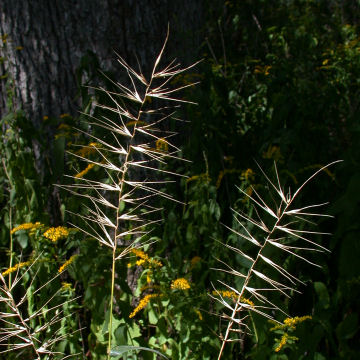

Hystrix patula - (image 1 of 2)
Taxonomy
Family: Poaceae
Habitat
Common in woodlands.
Associates
Acer saccharum, Aster shortii, Bromus pubescens, Elymus villosus, Eupatorium rugosum, Fraxinus americana, Galium concinnum, Geum canadense, Impatiens pallida, Ostrya virginiana, Parthenocissus quinquefolia, Prunus serotina, Prunus virginiana, Quercus alba, Quercus rubra, Ranunculus septentrionalis, Sambucus canadensis, Thalictrum dioidum, Tilia americana, Ulmus americana, Ulmus rubra.
Distribution
East of the Rockies, absent from the southernmost states.
Morphology
Upright perennial grass to 5'. Leaves to 12" long and just under 1" wide, rough, diverging; sheaths smooth. Spikelets to 10" long, in two distinct rows on opposite sides of the rachis; glumes absent, or more often reduced to minute bristles or horns at the base of each spikelets; stamens 3; styles 2. Stem smooth.
Notes
Flowers mid June to mid July
Wetland indicator: Upland
Most common in woodlands that are regularly burned. The large spikelets resemble a bottebrush, hence the common name. An ornamental grass that does well in part shade. Some authors call this plant Elymus hystrix L.
Bibliography
Niering, W. A. 1979. The Audubon society field guide to North American
wildflowers: eastern region.
Knopf/Random House, New York.
Peterson, R. T. and M. McKenney. 1996. A Field Guide to Wildflowers:
Northeastern and North-Central North America.
Houghton Mifflin Company. Boston, MA
Swink, F. and G. Wilhelm. 1994. Plants of the Chicago Region.
Indiana Academy of Science. The Morton Arboretum. Lisle, Illinois.
|
Michael Hough © 2005 |